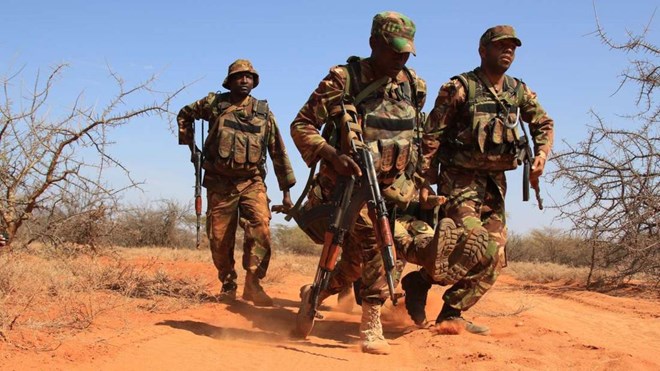
Friday October 16, 2020
By CONSTANT MUNDA

Kenyan soldiers do post-explosion drill during the Kenya Defence Forces and British Army joint training at Archer’s Post in Samburu County on October 7, 2020. PHOTO | JOSEPH KANYI | NMG
Cash reimbursed to Kenya for its troops fighting Al-Shabaab militants in Somalia by the European Union (EU) and its partners for the year ended June 2020 grew 7.5 percent or Sh324 million ($2,982,870) even as Nairobi considered pulling out its forces next year.
Latest Treasury data shows refunds from the African Union Mission in Somalia (Amisom) amounted to nearly Sh4.64 billion ($40,508,116), up from Sh4.32 billion ($39,771,604) the previous year, defying expectations at a time resources held by key partners such as the 27-nation EU and the United Nations are being concentrated in containing the spread of Covid-19.
The refunds to Kenya, through the African Union Peace Fund, have been falling, indicating that Nairobi has been gradually reducing the size of its defence forces in the war-torn Somalia as the initial UN-backed exit draws closer.
The Federal Government of Somalia — backed by the UN Security Council and the African Union— is working on the Somalia Transition Plan aimed at transferring security responsibility to Somali National Security Forces ahead of Amisom’s planned exit in 2021.
Defence Cabinet Secretary Monica Juma earlier this week reiterated that withdrawal of the Amisom forces was dependent on defeating Al-Shabaab and the capacity of the Somali forces to handle security on their own.
“This (withdrawal of Amisom forces) is an agenda that remains on the table of the (UN) Security Council and every so often, in fact every six months, we invariably have the status of Somalia being deliberated,” she said in an interview published in the Sunday Nation.
“So it’s an evolving situation and that is what is going to guide us.”
The grants from Amisom fell short of the Sh5 billion target the Treasury had set for the financial year ended June 2020 by Sh361 million ($3,323,506).
In the current financial year ending June 2021, the Treasury has budgeted for Sh3.5 billion ($32,222,365) — which is less than half the Sh7.44 billion ($68,495,541) it got in the year ended June 2017.
The Treasury projects the Amisom refunds to fall further to Sh3 billion ($27,619,170) in the year starting July 2021.
Kenya formally sent about 4,660 soldiers to Somalia in October 2011 after incessant attacks and kidnapping of civilians by Al-Shabaab militants within its territory, numbers which have since been trimmed.
A year later, the UN Security Council gave Kenya the green light to join Amisom, a decision that meant the Treasury would not bear the full costs of the incursion.
Amisom’s forces are drawn from Uganda, Burundi, Djibouti, Sierra Leone and Kenya, and are currently commanded by Burundi’s Lt. Gen Diomede Ndegeya who took over in August from Lt Gen Tigabu Yilma Wondimhunegn of Ethiopia.
The EU funds cater for allowances for the Amisom troops and police, international and local civilian staff salaries, operational costs of their offices, among others.
The United Nations Support Office in Somalia (UNSOS), on the other hand, provides logistical field support to the Amisom troops and Somali National Security Forces during joint operations.
The Kenya Defence Forces (KDF), in the book titled “War for Peace: Kenya’s Military in the African Mission in Somalia, 2011-2020” published May 8, lists reforming the Somali National Army to take charge of sustainable peace as the first pillar of the exit plan.
The second pillar is creating a “stable, peaceful and prosperous” Jubbaland, which has enjoyed relative peace amid years of civil strife in mainland Somalia.
“This will involve securing routes in Jubbaland accessible to and used by Al-Shabaab, including areas in Jilib, the roads to Kenyan border points (Liboi, El-Wak, Mandera, Gherille and Boni forest) and Indian Ocean ports of Ras Kamboni, Kuday, Kismayu and Barawe,” the book says.